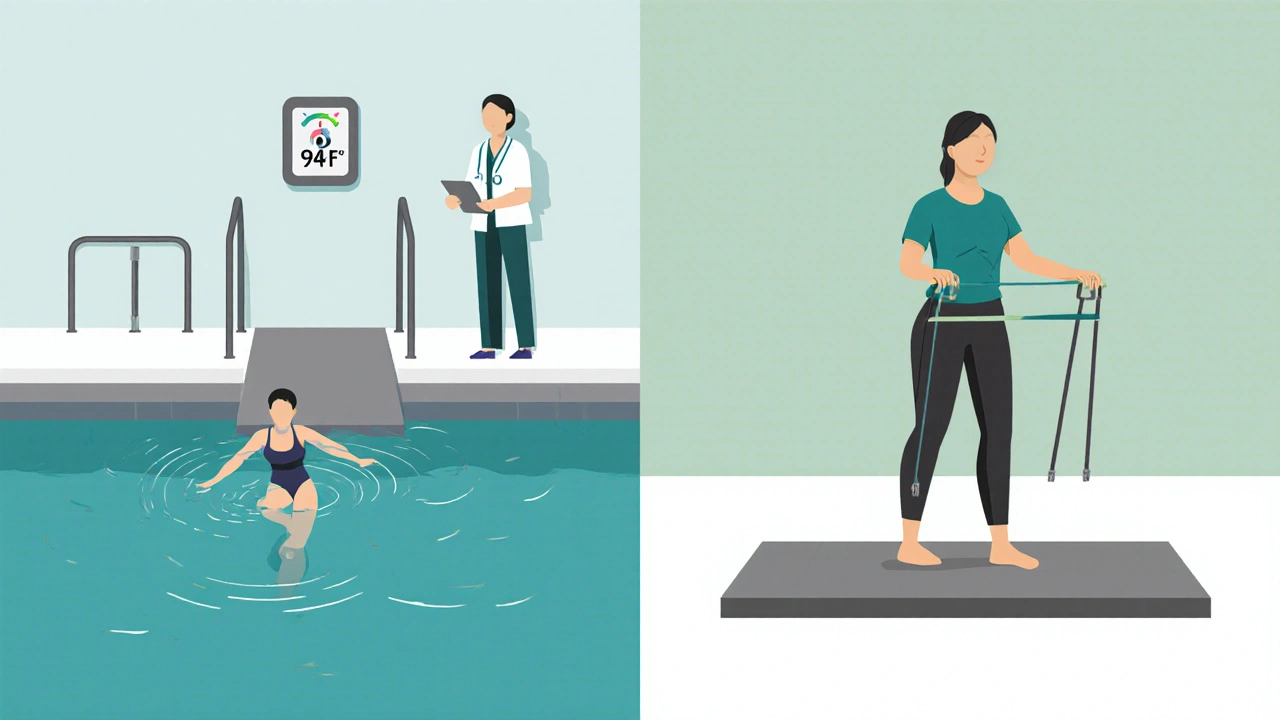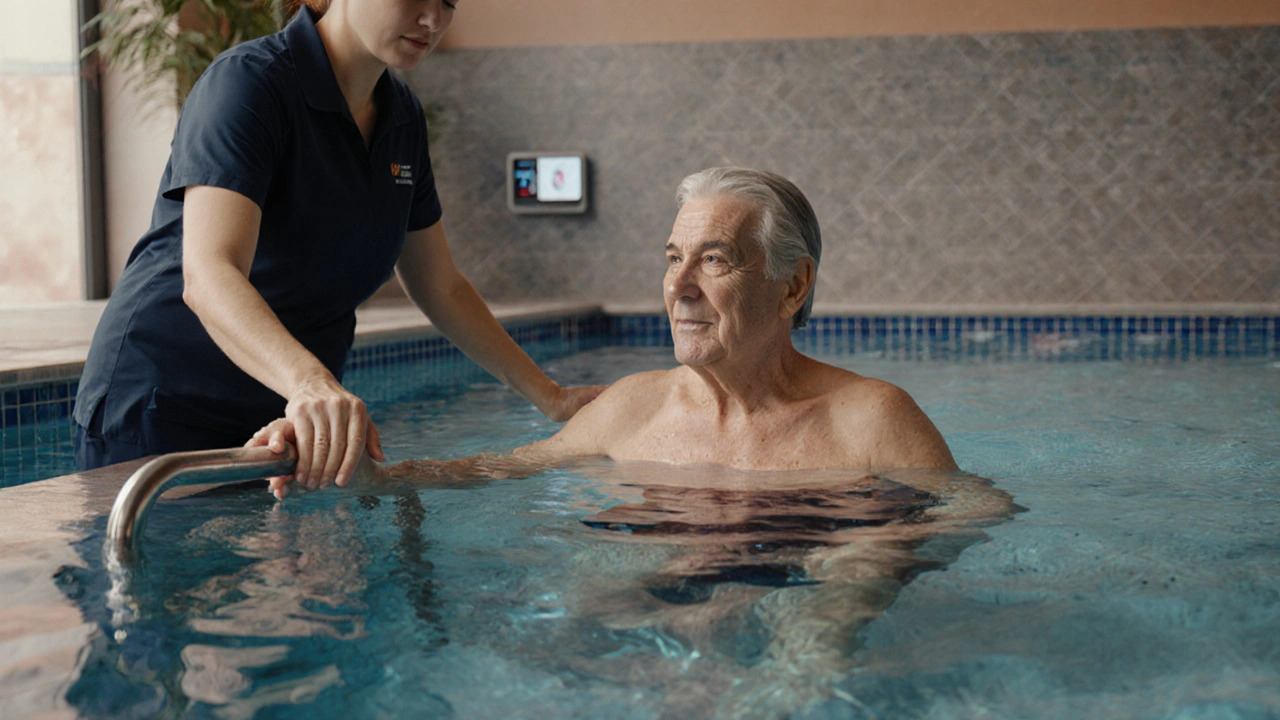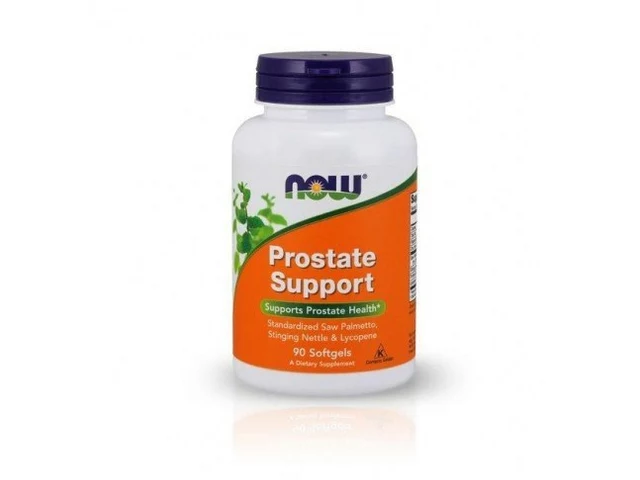Aquatic Therapy Benefits Calculator
Estimated Benefits
Mobility Improvement
-
Spasticity Reduction
-
Energy Boost
-
Safety Profile
-
Key Takeaways
- Aquatic therapy boosts mobility and reduces muscle spasticity for people with sclerosis.
- The warm water environment lowers pain, improves circulation, and supports neuroplastic changes.
- Combining pool sessions with land‑based exercises yields faster overall progress.
- Safety guidelines-temperature, supervision, and gradual intensity-keep sessions effective.
- Insurance often covers specialized aquatic programs when prescribed by a neurologist.
When you hear the word aquatic therapy, you probably picture someone doing gentle stretches in a pool. For people living with sclerosis-especially multiple sclerosis-those gentle movements can translate into big life changes. Below we break down why the water works, how to start safely, and what to expect compared with conventional rehab.
What Is Aquatic Therapy?
Aquatic Therapy is a form of physical therapy performed in a heated pool, using water’s buoyancy, resistance, and temperature to aid movement and recovery. The water supports the body, letting patients move joints they might otherwise avoid because of pain or weakness. The constant pressure also encourages blood flow, while the gentle resistance works the muscles without over‑loading them.
Why It Matters for Sclerosis Patients
Sclerosis, most commonly multiple sclerosis (MS), is a neurological condition that attacks the protective myelin sheath around nerves. The result is muscle weakness, spasticity, balance loss, and chronic fatigue. Traditional land‑based physical therapy helps, but the water adds three key advantages:
- Reduced weight‑bearing stress, letting patients practice movements they can’t do on solid ground.
- Uniform resistance that strengthens muscles in a balanced way.
- Warm temperatures that relax tight muscles and lessen pain signals.

Core Benefits Explained
1. Improves Mobility and Gait
Because water bears up to 90% of body weight, patients can practice walking, stepping, and turning with far less risk of falling. Research from the National MS Society (2023) showed a 30% improvement in timed‑up‑and‑go tests after twelve weeks of twice‑weekly pool sessions.
2. Reduces Muscle Spasticity
Spasticity-a hallmark of MS-causes involuntary muscle tightening. The warm water (typically 90‑95°F) raises skin temperature, which relaxes muscle fibers. A 2022 clinical trial on hydrotherapy reported a 25% drop in Modified Ashworth Scale scores after eight weeks.
3. Boosts Cardiovascular Health
Water creates resistance in every direction, meaning the heart works harder even at low speeds. Patients often see a modest rise in VO₂ max, translating to better endurance for daily tasks.
4. Enhances Mood and Reduces Fatigue
The soothing sensation of water triggers endorphin release. One survey of 150 MS patients found a 40% reduction in self‑reported fatigue levels after a three‑month aquatic program.
5. Supports Neuroplasticity
Neuroplasticity is the brain’s ability to reorganize itself by forming new neural connections. Repetitive, low‑impact movements in a novel environment (the pool) stimulate new pathways, helping the nervous system compensate for damaged areas.
Related Concepts You’ll Hear About
Understanding a few companion terms helps you talk intelligently with therapists and insurers:
- Multiple Sclerosis is a chronic autoimmune disease that attacks the central nervous system, leading to varied physical and cognitive symptoms.
- Hydrotherapy is the therapeutic use of water for pain relief and treatment, of which aquatic therapy is a specialized, exercise‑focused branch.
- Physical Therapy is a clinical discipline that uses movement, manual techniques, and education to restore function.
- Spasticity is involuntary muscle tightening that interferes with smooth motion, a common symptom in MS.
- Balance Training is exercises designed to improve postural stability and reduce fall risk.
- Cardiovascular Fitness is the efficiency of the heart and lungs in delivering oxygen during sustained activity.
- Pain Management is strategies and therapies aimed at reducing or coping with chronic pain.
How to Get Started Safely
- Consult Your Neurologist: Ask for a referral to a certified aquatic therapist who knows MS‑specific precautions.
- Choose the Right Facility: Look for pools with a gradual entry ramp, handrails, and a heated environment (90‑95°F).
- Start Slow: Begin with 20‑minute sessions twice per week, focusing on gentle range‑of‑motion drills.
- Monitor Core Temperature: MS patients can be sensitive to overheating. Ensure the pool’s temperature stays within the therapeutic range and take breaks if you feel warm.
- Track Progress: Keep a simple log of distance walked, number of steps taken, and how you feel afterward. Share this with your therapist to adjust intensity.

Aquatic Therapy vs. Land‑Based Physical Therapy
| Feature | Aquatic Therapy | Land‑Based PT |
|---|---|---|
| Weight‑bearing stress | Reduced (up to 90% buoyancy) | Full body weight |
| Spasticity reduction | Warm water relaxes muscles | Relies on stretching, medication |
| Cardiovascular demand | Moderate due to resistance | Variable, often higher impact |
| Fall risk | Low - pool walls & buoyancy | Higher - uneven surfaces |
| Equipment needs | Pool, water‑proof cuffs | Gym floor, bands, weights |
| Insurance coverage (US, 2024) | Often covered when prescribed | Generally covered |
Both approaches have merit, but the pool’s low‑impact setting makes it especially friendly for those with severe fatigue or balance issues.
Tips to Maximize Your Sessions
- Wear tight‑fit swimsuits or compression garments to improve proprioception.
- Use waterproof resistance bands for added strength work.
- Incorporate breathing exercises-slow, diaphragmatic breaths enhance oxygen delivery and calm the nervous system.
- Stay hydrated; even though you’re in water, you still lose fluids.
- Schedule sessions at a time of day when energy levels are highest-often mid‑morning for many with MS.
Frequently Asked Questions
Is aquatic therapy safe for all stages of multiple sclerosis?
Most patients, even those with moderate disability, can safely participate as long as the pool is heated and a qualified therapist supervises. Those with severe heat intolerance should keep sessions short and monitor body temperature closely.
How often should I attend aquatic therapy?
Two to three times per week is typical for measurable gains. Consistency matters more than session length; 20‑30 minutes per visit is often enough for early improvements.
Will my insurance cover the cost?
Many U.S. plans reimburse aquatic therapy when a physician’s order is provided. Check with your insurer and ask the therapy center for a detailed treatment plan to submit for pre‑authorization.
Can I combine pool work with land exercises?
Absolutely. A hybrid program leverages the low‑impact benefits of water while maintaining bone‑strengthening weight‑bearing exercises on land. Your therapist can design a schedule that alternates modalities.
What should I wear to a session?
A snug swimsuit or compression briefs works best. Some centers provide water‑resistant shoes or sandals for added grip, but many patients prefer bare feet for better proprioception.
Whether you’re newly diagnosed or have been living with sclerosis for years, adding a few minutes of movement in a warm pool can shift the balance from limitation to possibility. Talk to your neurologist, find a certified aquatic therapist, and give the water a try-you might be surprised how quickly you start feeling stronger, steadier, and more relaxed.






NIck Brown
8 October 2025 - 19:07 PM
If you’re looking for a miracle cure, stop dreaming. Aquatic therapy is a useful tool, not a magic wand. The data shows modest gains, not overnight transformations. You still need solid rehab on land and proper medication.
Angelina Wong
14 October 2025 - 14:01 PM
Great points, Nick. For anyone starting out, remember that consistency beats intensity. Aim for two 30‑minute sessions per week and track mobility improvements. It’s also wise to get a physician’s green light before hitting the pool.
Anthony Burchell
20 October 2025 - 08:54 AM
Look, I get the hype but the water isn’t a universal fix. Some folks feel worse because of heat intolerance. It’s fine for a few, but don’t dump all your rehab budget into a splashy pool.
Michelle Thibodeau
26 October 2025 - 03:47 AM
Imagine stepping into a warm, buoyant oasis where gravity feels like a distant memory; that’s the core promise of aquatic therapy. The water’s gentle resistance encourages muscles to engage without the jarring impact of hard floors, which can be a game‑changer for spasticity. Over weeks, patients often report a softening of that relentless muscle tightness that plagues daily movement. Warmth at 90‑95°F relaxes fibers, allowing joint range‑of‑motion exercises that would otherwise be painful. Because the pool supports up to ninety percent of body weight, balance training can be practiced safely, reducing fear of falls. Studies from the National MS Society in 2023 showed a thirty percent improvement in timed‑up‑and‑go tests after twelve weeks of twice‑weekly sessions. That statistical boost translates into real‑world benefits like getting out of a chair faster or navigating crowded aisles with confidence. Cardiovascular demand rises subtly as you push against water in every direction, which can improve VO₂ max even for low‑impact participants. The endorphin surge triggered by rhythmic movement also lifts mood and slashes perceived fatigue levels. A survey of one‑hundred‑fifty MS patients recorded a forty percent drop in self‑reported fatigue after three months of aquatic work. Moreover, the novel sensory environment of water may stimulate neuroplastic pathways, helping the brain rewire around damaged circuits. While the science is still evolving, the consensus among neurologists is that water‑based rehab complements land‑based protocols nicely. It’s not a standalone cure, but a valuable piece of the puzzle that can tip the scales toward independence. If you’re on the fence, try a short trial period under a certified therapist and log your progress; numbers rarely lie. In short, the pool can turn a daunting rehab journey into a more enjoyable, sustainable experience.
Patrick Fithen
31 October 2025 - 22:41 PM
Water therapy is like a meditation in motion it lets you move without the usual pain and the buoyancy gives the body a chance to relearn patterns the mind often forgets in the fight against sclerosis
Kimberly Newell
6 November 2025 - 17:34 PM
yep totally agree with patrick, teh water feels like a hug for ur muscles and u can actually enjoy the sesh instead of dreading it. just make sure u dont stay too long or u'll get overheated lol
David Brice
12 November 2025 - 12:27 PM
Stop whining about “just a few weeks” and get your butt into the pool already. If you think a warm bath is enough you’re clueless. Dive in, push yourself, and stop making excuses for every tiny setback.
Zachary Schroer
18 November 2025 - 07:21 AM
🤔💦 your point is taken but remember the pool is not a trendy spa its a rehab tool 🚀💪
Sheila Hood
24 November 2025 - 02:14 AM
Oh sure, because everyone loves getting soaked while trying to walk.
Melissa Jansson
29 November 2025 - 21:07 PM
From a physiotherapy standpoint, the hydrostatic pressure coupled with thermodynamic gradients facilitates proprioceptive feedback loops, thereby optimizing motor relearning pathways in demyelinated neural substrates.
Max Rogers
5 December 2025 - 16:01 PM
Hey folks, just a heads‑up: before you book that pool slot, double‑check your insurance pre‑auth. A quick call can save you a lot of paperwork later, and it’ll keep your wallet happy.